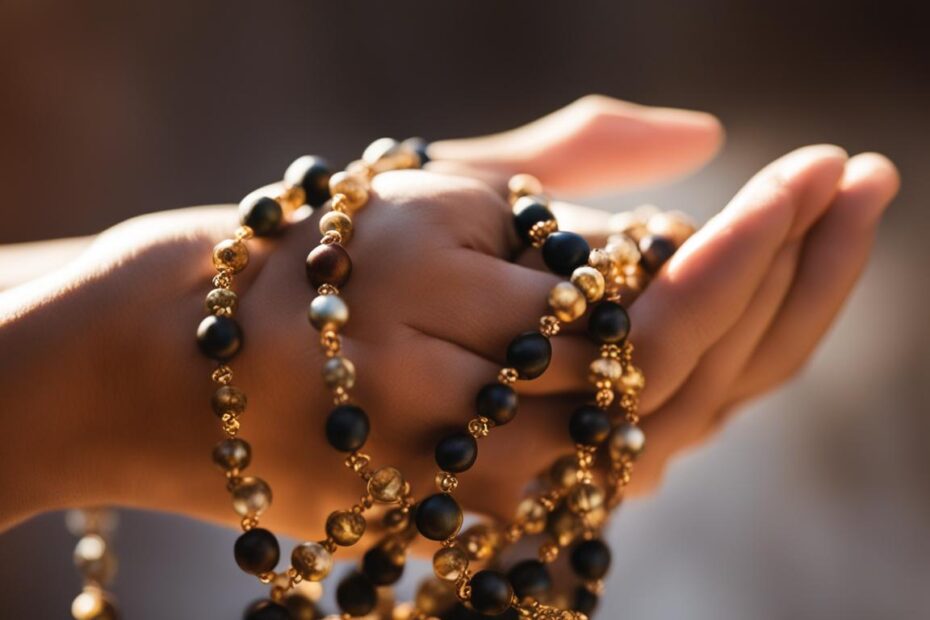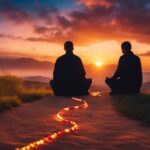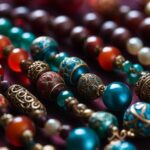Praying the Holy Rosary is a cherished tradition in the Catholic faith. It is a beautiful devotional practice that allows believers to communicate with God, seek His intercession, and deepen their faith. In this comprehensive guide, we will take you through the step-by-step process of praying the Holy Rosary, ensuring that you understand the traditional Catholic prayer method and the significance behind each step.
Key Takeaways:
- Praying the Holy Rosary is a devotional practice in the Catholic faith.
- It involves using rosary beads to count prayers and communicate with God.
- The Rosary is a means of seeking God’s intercession and deepening one’s faith.
- There are specific prayers and mysteries associated with the Rosary.
- By following the step-by-step guide, individuals can master the art of praying the Holy Rosary and experience its transformative power.
Understanding the Purpose and Significance of the Holy Rosary
The Holy Rosary is a significant spiritual practice in the Catholic faith, serving multiple purposes and holding great significance for believers. It is a form of prayer that allows individuals to seek God’s favor, express gratitude, and meditate on the life and teachings of Jesus and Mary. The Rosary is a powerful tool for deepening one’s faith and cultivating a closer relationship with God.
Praying the Rosary is a faith-based practice that offers a structured guide for prayer and meditation. It engages the senses by using rosary beads to count prayers, creating a physical and tangible experience of devotion. The repetitive nature of the prayers allows for focused contemplation and quiet reflection, enabling believers to enter into a state of spiritual connection and peace.
The Holy Rosary is a means of seeking God’s intercession, expressing love and reverence for Mary, and immersing oneself in the mysteries of the faith.
By engaging in the Rosary, individuals immerse themselves in the mysteries of the faith through the recitation of specific prayers and meditation on the life of Christ. This practice allows for a deeper understanding and internalization of the teachings of Jesus, leading to spiritual growth and transformation.
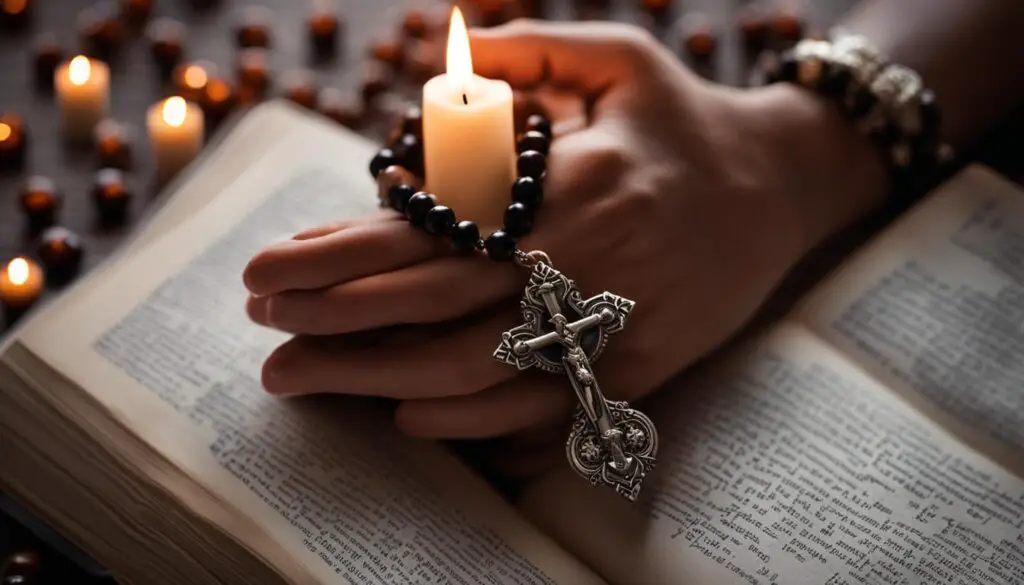
The Significance of the Holy Rosary
The Holy Rosary holds immense significance as a spiritual practice within the Catholic tradition. It offers believers a way to express their faith, seek spiritual guidance, and connect with God and the Blessed Virgin Mary. Through the recitation of prayers and meditation on the mysteries, individuals can experience a sense of peace, clarity, and divine presence.
Embracing the practice of the Holy Rosary is a personal journey that enables believers to deepen their relationship with God and cultivate a richer spiritual life. It serves as a reminder of the love, mercy, and sacrifice of Jesus and the intercessory power of Mary. The Rosary is not merely a set of prayers, but a profound spiritual encounter that can strengthen one’s faith and bring about transformative change.
Getting Started: The Basic Prayers of the Rosary
The Rosary, a powerful prayer practice in the Catholic faith, begins with a set of foundational prayers. These prayers serve as the building blocks for the entire Rosary and are recited on specific beads of the rosary. They include the Apostles’ Creed, Our Father, Hail Mary, and Glory Be.
The Apostles’ Creed is a statement of faith and belief in the teachings of Christianity. It affirms the foundational principles of the Catholic faith and sets the tone for the Rosary. Reciting the Apostles’ Creed helps Catholics align their hearts and minds with the core beliefs of their religion.
The Our Father is a prayer taught by Jesus Himself and is considered the perfect prayer. It acknowledges God as our father, seeks His guidance, and asks for daily sustenance. The Our Father is recited to honor the relationship between God and His children.
The Hail Mary is a prayer dedicated to the Virgin Mary, the mother of Jesus. It is a plea for her intercession and a way to seek her guidance and protection. The Hail Mary consists of two parts: the greeting by the Angel Gabriel and the request for Mary’s intercession. It is repeated multiple times during the Rosary.
The Glory Be is a short prayer that praises the Holy Trinity. It acknowledges the glory and power of God, the Father, Son, and Holy Spirit. Reciting the Glory Be brings honor to God and reinforces the belief in His divine nature.
| Prayer | Description |
|---|---|
| Apostles’ Creed | A statement of faith and belief in the teachings of Christianity. |
| Our Father | A prayer taught by Jesus Himself, acknowledging God as our Father. |
| Hail Mary | A prayer dedicated to the intercession of the Virgin Mary. |
| Glory Be | A short prayer that praises the Holy Trinity. |
The Mysteries of the Rosary
The Mysteries of the Rosary form an integral part of the Catholic devotion and serve as a meditation technique during the prayer. Each Rosary consists of five decades, with each decade representing a specific mystery related to the life of Jesus and Mary. These mysteries provide a framework for deep reflection and connection with God.
The Joyful Mysteries
The Joyful Mysteries focus on the early life of Jesus and the Blessed Virgin Mary. They include the Annunciation, when the angel Gabriel announced to Mary that she would conceive Jesus; the Visitation, when Mary visited her cousin Elizabeth while both were pregnant; the Nativity, the birth of Jesus in Bethlehem; the Presentation, when Jesus was presented in the temple; and the Finding of the Child Jesus in the Temple, when Jesus was found discussing with the teachers.
The Luminous Mysteries
The Luminous Mysteries were introduced by Pope John Paul II in 2002. They highlight significant moments in Jesus’ public ministry. They include the Baptism of Jesus in the River Jordan, the Wedding Feast at Cana where Jesus performed his first miracle, the Proclamation of the Kingdom of God, the Transfiguration when Jesus’ divine glory was revealed, and the Institution of the Holy Eucharist at the Last Supper.
The Sorrowful Mysteries
The Sorrowful Mysteries focus on the suffering and sacrifice of Jesus. They include the Agony of Jesus in the Garden of Gethsemane, where he accepted his impending crucifixion; the Scourging at the Pillar, when Jesus was whipped before his crucifixion; the Crowning with Thorns, when Jesus was mocked and crowned with thorns; the Carrying of the Cross, when Jesus carried the cross to Calvary; and the Crucifixion, Jesus’ ultimate sacrifice for humanity.
The Glorious Mysteries
The Glorious Mysteries celebrate the triumph and glory of Jesus and Mary. They include the Resurrection of Jesus, his triumph over death; the Ascension of Jesus into heaven; the Descent of the Holy Spirit during Pentecost; the Assumption of Mary into heaven; and the Coronation of Mary as Queen of Heaven and Earth.
| Mystery | Description |
|---|---|
| Joyful Mysteries | Focus on the early life of Jesus and Mary |
| Luminous Mysteries | Highlight significant moments in Jesus’ public ministry |
| Sorrowful Mysteries | Reflect on the suffering and sacrifice of Jesus |
| Glorious Mysteries | Celebrate the triumph and glory of Jesus and Mary |
Praying the Rosary while meditating on these mysteries provides a powerful intercessory prayer method for Catholics. It allows believers to enter into the sacred stories of Jesus and Mary, deepening their Catholic devotion and fostering a stronger connection with God.

Praying the Rosary: Step-by-Step Guide
Praying the Rosary is a beautiful and meditative practice that allows Catholics to strengthen their connection with God and Mary. By following a step-by-step guide, you can easily engage in this powerful form of prayer. Here are the essential steps to say the rosary:
- Begin with the Sign of the Cross: Start by making the Sign of the Cross, symbolizing your faith in the Holy Trinity.
- Recite the Apostles’ Creed: Declare your belief in the foundational teachings of Christianity.
- Say the Our Father: Recite the prayer taught by Jesus to his disciples.
- Pray ten Hail Marys: Repeat the Hail Mary prayer while contemplating the mystery for the decade.
- Recite the Glory Be: Offer praise and glory to the Father, Son, and Holy Spirit.
- Announce the next mystery: State the specific mystery related to the decade you are about to pray.
- Repeat steps 4 to 6 for each decade: Pray the Hail Marys and Glory Be while reflecting on each mystery.
- Conclude with the Hail, Holy Queen: End the Rosary with a prayer dedicated to Mary’s intercession.
You can use rosary beads to keep track of the prayers, moving from one bead to the next for each prayer. It’s important to approach the Rosary with a spirit of reverence and focus, allowing the prayers and mysteries to deepen your faith and connection with God.
Remember that the Rosary can be a personal and intimate form of prayer. You can adapt the steps and incorporate your own intentions, desires, and reflections into each prayer. Through the Rosary, you have the opportunity to enter into a sacred space and seek solace, guidance, and spiritual nourishment.
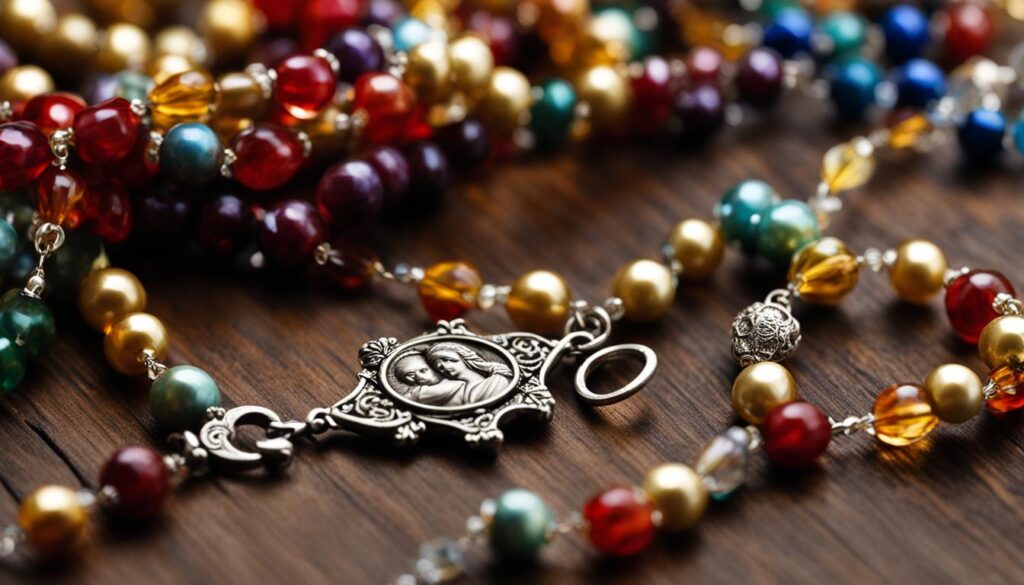
The Joyful Mysteries
The Joyful Mysteries of the Holy Rosary focus on the early life of Jesus and the significant events surrounding His birth and childhood. These mysteries invite believers to reflect on the profound joy and grace brought into the world through Jesus and His mother, Mary.
1. The Annunciation: This mystery commemorates the Angel Gabriel’s visit to Mary, where he announced that she would conceive and bear the Son of God. It symbolizes Mary’s humble acceptance of God’s plan and her role in the salvation of humanity.
2. The Visitation: In this mystery, Mary visits her cousin Elizabeth, who is also miraculously pregnant. It portrays the meeting of two expectant mothers and the recognition of the divine presence within each of their unborn children.
3. The Nativity: The Nativity of Jesus represents His humble birth in Bethlehem, where He was laid in a manger. This mystery reminds believers of the hope and joy that Christ’s birth brings to the world.
4. The Presentation: Mary and Joseph present the infant Jesus in the temple. Here, Jesus is recognized by Simeon and Anna as the long-awaited Messiah. This mystery highlights Jesus’ dedication to God’s plan and His mission.
5. The Finding of the Child Jesus in the Temple: When Jesus was twelve years old, He went missing during a pilgrimage to Jerusalem with His parents. They found Him in the temple, engaging with the teachers of the law. This mystery reveals Jesus’ wisdom and His commitment to His Father’s house.
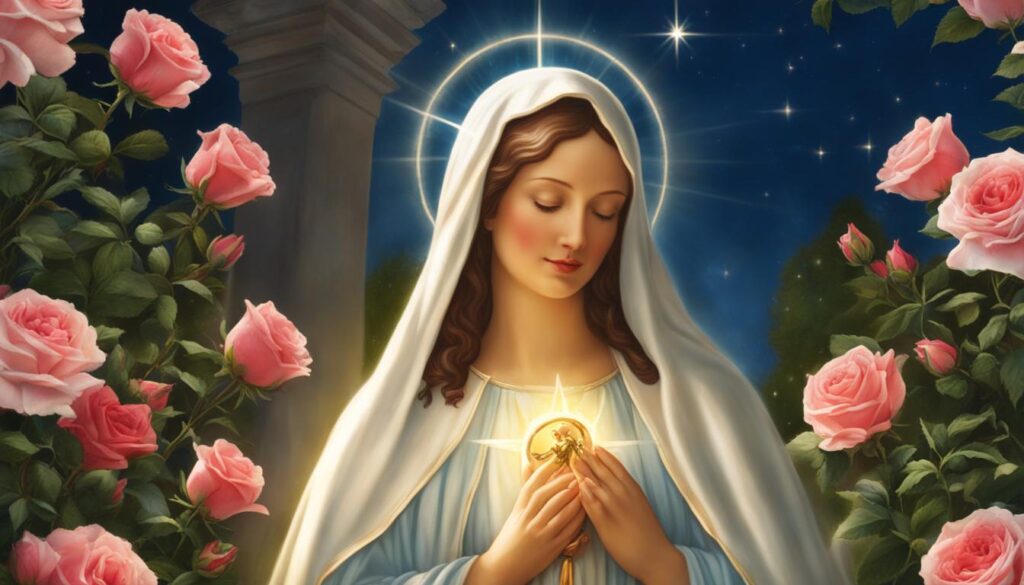
Table: The Joyful Mysteries of the Holy Rosary
| Mystery | Description |
|---|---|
| The Annunciation | The Angel Gabriel announces to Mary that she will conceive and bear the Son of God. |
| The Visitation | Mary visits her cousin Elizabeth, who is also miraculously pregnant with John the Baptist. |
| The Nativity | Jesus is born in Bethlehem, laid in a manger, and visited by shepherds and wise men. |
| The Presentation | Mary and Joseph present Jesus in the temple, where He is recognized by Simeon and Anna. |
| The Finding of the Child Jesus in the Temple | Mary and Joseph find Jesus in the temple, conversing with the teachers of the law. |
The Luminous Mysteries
The Luminous Mysteries are a significant addition to the traditional Rosary, introduced by Pope John Paul II in 2002. These mysteries center around five key moments in the public ministry of Jesus, shedding light on His teachings, miracles, and sacraments. By meditating on the Luminous Mysteries, Catholics can deepen their understanding of Jesus’ mission and the relevance of His teachings in their lives.
Baptism in the River Jordan
The first Luminous Mystery is the Baptism in the River Jordan. This event marked the beginning of Jesus’ public ministry and symbolized His humility and identification with humanity. As Jesus was baptized by John the Baptist, the heavens opened, and the Holy Spirit descended upon Him, affirming His divine mission. This mystery invites believers to reflect on their own baptism and the call to live as children of God.
Wedding Feast at Cana
The second Luminous Mystery is the Wedding Feast at Cana. It was during this event that Jesus performed His first public miracle, turning water into wine. Through this act, Jesus revealed His divine power and showed His care for the joys and celebrations of human life. This mystery encourages believers to trust in Jesus’ ability to transform and bless their everyday experiences.
Preaching of the Kingdom of God
The third Luminous Mystery focuses on Jesus’ preaching of the Kingdom of God. Throughout His ministry, Jesus proclaimed the Good News, calling people to repentance and inviting them into a deeper relationship with God. This mystery prompts believers to examine their own lives and consider how they can advance God’s kingdom through their words and actions.
Transfiguration
The Transfiguration is the fourth Luminous Mystery, where Jesus revealed His divine glory to Peter, James, and John on Mount Tabor. In the presence of Moses and Elijah, Jesus’ face shone like the sun, and His clothes became dazzling white. This mystery invites believers to reflect on the true nature of Jesus and the transformative power of His presence in their lives.
Institution of the Holy Eucharist
The fifth and final Luminous Mystery is the Institution of the Holy Eucharist. During the Last Supper, Jesus shared a meal with His disciples, where He instituted the sacrament of the Eucharist. He took bread, blessed it, broke it, and gave it to His disciples, saying, “Take, eat; this is my body.” This mystery calls believers to reflect on the real presence of Jesus in the Eucharist and the profound gift of His body and blood.

| Mystery | Description |
|---|---|
| Baptism in the River Jordan | Jesus’ baptism by John the Baptist, symbolizing His identification with humanity. |
| Wedding Feast at Cana | Jesus’ first public miracle, turning water into wine at a wedding celebration. |
| Preaching of the Kingdom of God | Jesus’ proclamation of the Good News and invitation to enter into a deeper relationship with God. |
| Transfiguration | Jesus’ manifestation of His divine glory to Peter, James, and John on Mount Tabor. |
| Institution of the Holy Eucharist | Jesus’ establishment of the sacrament of the Eucharist during the Last Supper. |
The Sorrowful Mysteries
The Sorrowful Mysteries of the Holy Rosary center around the profound suffering endured by Jesus on His journey to the cross. These mysteries invite us to reflect on the Agony of Jesus in the Garden, the Scourging at the Pillar, the Crowning with Thorns, the Carrying of the Cross, and the Crucifixion. Each mystery encapsulates a unique aspect of Jesus’ selfless love and sacrifice for humanity.
The first Sorrowful Mystery, the Agony of Jesus in the Garden, recalls the intense anguish Jesus experienced as He prayed in anticipation of His crucifixion. It symbolizes His willingness to bear the weight of our sins and His unwavering commitment to fulfilling God’s plan for salvation.
The second Mystery, the Scourging at the Pillar, represents the brutal physical torture Jesus endured at the hands of Roman soldiers. This act of unimaginable cruelty demonstrates the depth of Jesus’ love for us and His willingness to suffer for our redemption.
The third Mystery, the Crowning with Thorns, recounts the mockery and humiliation Jesus faced when Roman soldiers placed a crown of thorns upon His head. This painful and degrading act highlights the injustice and rejection Jesus endured as the King of Kings.
The fourth Mystery, the Carrying of the Cross, depicts Jesus’ arduous journey to Calvary, where He would be crucified. As He bore the weight of the cross, Jesus’ physical and emotional pain serves as a powerful reminder of His immense love and sacrifice for humanity.
The fifth and final Sorrowful Mystery, the Crucifixion, represents Jesus’ ultimate act of selflessness and the fulfillment of His mission. On the cross, Jesus offered Himself as the perfect sacrifice, pouring out His blood to atone for our sins and reconcile us with God.
| Mystery | Keyword |
|---|---|
| Agony of Jesus in the Garden | Agony of Jesus in the Garden |
| Scourging at the Pillar | Scourging at the Pillar |
| Crowning with Thorns | Crowning with Thorns |
| Carrying of the Cross | Carrying of the Cross |
| Crucifixion | Crucifixion |
The Sorrowful Mysteries of the Rosary allow believers to enter into the depth of Jesus’ suffering and to reflect on the profound love and mercy He demonstrated through His sacrifice. By meditating on these mysteries, Catholics are invited to unite their own sufferings with Christ’s, finding strength, hope, and solace in His example.
The Glorious Mysteries
The Glorious Mysteries of the Holy Rosary focus on the triumphant events in the lives of Jesus and Mary. These mysteries invite believers to reflect on the fulfillment of God’s promises and the hope of eternal life. Each mystery is a testament to the power of faith and the victory of God’s love over sin and death.
The first Glorious Mystery is the Resurrection, which celebrates Jesus’ triumph over death. It is a reminder that through His resurrection, Jesus offers eternal life to all who believe in Him. The second mystery is the Ascension, where Jesus returns to heaven in glory, promising to prepare a place for His followers. The third mystery, the Descent of the Holy Spirit, marks the coming of the Holy Spirit upon the apostles, empowering them to spread the teachings of Jesus.
The fourth mystery, the Assumption of Mary, acknowledges Mary’s unique role in God’s plan of salvation. It commemorates her being taken body and soul into heaven at the end of her earthly life. The final mystery, the Coronation of Mary, honors Mary as Queen of Heaven and Earth, sharing in the glory of her Son’s kingdom.
| Mystery | Description |
|---|---|
| Resurrection | Celebrates Jesus’ triumph over death and His offer of eternal life. |
| Ascension | Recognizes Jesus’ return to heaven and His promise to prepare a place for His followers. |
| Descent of the Holy Spirit | Commemorates the coming of the Holy Spirit upon the apostles, empowering them for their mission. |
| Assumption of Mary | Honors Mary being taken body and soul into heaven at the end of her earthly life. |
| Coronation of Mary | Recognizes Mary as Queen of Heaven and Earth, sharing in the glory of her Son’s kingdom. |
The Glorious Mysteries offer believers a profound and hopeful meditation on the ultimate victory of God’s love. By contemplating these events, individuals can find solace, inspiration, and a renewed sense of purpose in their own spiritual journey. The Rosary serves as a powerful tool for connecting with God’s grace and deepening one’s faith in the promises of the Glorious Mysteries.
The Divine Mercy Chaplet and the Rosary
The Divine Mercy Chaplet is a powerful prayerful meditation that complements the Rosary in the Catholic faith. Both the Rosary and the Divine Mercy Chaplet involve the use of rosary beads, which serve as a tangible aid in prayer and reflection.
While the Rosary encompasses the mysteries of Jesus’ life and the intercession of Mary, the Divine Mercy Chaplet focuses specifically on invoking God’s mercy and forgiveness. It is a beautiful prayer that encourages believers to trust in God’s abundant love and seek His mercy.
When praying the Divine Mercy Chaplet, the familiar rhythm of the Rosary is maintained. It begins with the Sign of the Cross, followed by the recitation of the Our Father, Hail Mary, and the Apostles’ Creed. The Chaplet then continues with a series of prayers, including the repetition of the phrase “For the sake of His sorrowful Passion, have mercy on us and the whole world.”
The Divine Mercy Chaplet is a beautiful addition to one’s prayer life, offering a contemplative and meditative way to connect with God’s mercy. It can be prayed individually or in a group setting, providing a sense of unity and collective intercession. Incorporating both the Rosary and the Divine Mercy Chaplet into one’s spiritual practice can deepen one’s relationship with God and foster a greater sense of peace and forgiveness.
The Historical Significance of the Rosary
The Rosary holds a significant place in Christian prayer tradition and has a long and fascinating history. Its origins can be traced back to the 13th century when the Blessed Virgin Mary appeared to St. Dominic de Guzman and introduced the prayer as a means of deepening devotion to Jesus. Since then, the Rosary has been embraced by Catholics worldwide as a powerful tool for spiritual growth and connection with God.
This ancient prayer practice of using beads for counting and reciting prayers has roots in various religious traditions, including Hinduism, Buddhism, Islam, and Judaism. In the Catholic tradition, the Rosary became a cherished devotion, with its structure and prayers carefully designed to foster reflection, meditation, and contemplation on the life and teachings of Jesus Christ.
Throughout history, the Rosary has played a significant role in the lives of the faithful. It has been associated with miraculous interventions, spiritual conversions, and the preservation of faith in times of turmoil. The Rosary has been embraced by saints, popes, and countless individuals seeking solace, guidance, and a deeper connection with the Divine.
The Power of Tradition
The Rosary is not merely a prayer but also a living testament to the enduring power of tradition within the Catholic Church. It has been passed down through generations, carrying with it the prayers and devotion of countless believers. The Rosary serves as a tangible link to the past, connecting present-day Catholics with the faith and spirituality of their ancestors.
“The Rosary serves as a tangible link to the past, connecting present-day Catholics with the faith and spirituality of their ancestors.”
A Universal Prayer for All
One of the unique aspects of the Rosary is its universal appeal. It transcends cultural, linguistic, and geographical boundaries, uniting Catholics from all walks of life in a common prayer experience. Whether recited in English, Spanish, French, or any other language, the Rosary holds the same timeless beauty and offers the same profound spiritual benefits.
Preserving the Rich Heritage
As Christians continue to embrace and pass on the tradition of the Rosary, they contribute to the preservation of a rich heritage that has shaped the identity of the Catholic Church for centuries. By praying the Rosary, both individually and as a community, believers honor the devotion and piety of those who came before them, ensuring that this cherished prayer practice endures for generations to come.
Conclusion
In conclusion, the Holy Rosary is a powerful spiritual practice that allows Catholics to deepen their faith and connect with God and the Blessed Virgin Mary. By following the step-by-step guide and incorporating the mysteries into prayer, individuals can experience the transformative power of the Rosary in their lives.
The Rosary provides a structured framework for prayer, meditation, and contemplation. Through the recitation of the Apostles’ Creed, Our Father, Hail Mary, and Glory Be, Catholics can express their faith, seek God’s intercession, and offer gratitude. The mysteries of the Rosary further enhance the prayer experience by focusing on significant events in the life of Jesus and Mary.
The Joyful Mysteries, Luminous Mysteries, Sorrowful Mysteries, and Glorious Mysteries provide a framework for meditation and reflection, allowing believers to delve deeper into the life and teachings of Jesus. Additionally, the Divine Mercy Chaplet complements the Rosary by emphasizing God’s mercy and forgiveness.
In summary, the Holy Rosary is a spiritual tradition that has deep historical significance and holds immense value for Catholics. Through the continuous practice of the Rosary, individuals can strengthen their relationship with God, nurture their faith, and experience the transformative power of prayer.
FAQ
What is the purpose of praying the Holy Rosary?
The Holy Rosary is a devotional practice in the Catholic faith that allows believers to communicate with God, seek His intercession, and deepen their faith.
What are the basic prayers of the Rosary?
The basic prayers of the Rosary include the Apostles’ Creed, Our Father, Hail Mary, and Glory Be.
How do I pray the Rosary step by step?
The process of praying the Rosary involves reciting the prayers while reflecting on the mysteries. It includes announcing the mystery, reciting the Our Father, ten Hail Marys, and the Glory Be for each decade.
What are the different sets of mysteries?
There are four sets of mysteries in the Rosary: the Joyful Mysteries, the Luminous Mysteries, the Sorrowful Mysteries, and the Glorious Mysteries.
What do the Joyful Mysteries focus on?
The Joyful Mysteries focus on significant events in the early life of Jesus, such as the Annunciation, Visitation, Nativity, Presentation, and Finding of the Child Jesus in the Temple.
What are the Luminous Mysteries?
The Luminous Mysteries, introduced by Pope John Paul II, highlight important moments in Jesus’ public ministry, including the Baptism in the River Jordan, Wedding Feast at Cana, Preaching of the Kingdom of God, Transfiguration, and Institution of the Holy Eucharist.
What do the Sorrowful Mysteries focus on?
The Sorrowful Mysteries invite reflection on the suffering and sacrifice of Jesus. They include the Agony of Jesus in the Garden, Scourging at the Pillar, Crowning with Thorns, Carrying of the Cross, and Crucifixion.
What are the Glorious Mysteries?
The Glorious Mysteries celebrate the triumph of Jesus and Mary, including the Resurrection, Ascension, Descent of the Holy Spirit, Assumption of Mary, and Coronation of Mary.
What is the Divine Mercy Chaplet?
The Divine Mercy Chaplet is a complementary prayer to the Rosary that focuses on invoking God’s mercy and forgiveness. It is shorter in length and specific to this intention.
What is the historical significance of the Rosary?
The use of rosary beads for prayer has a long history in various religious traditions, but the Catholic Rosary has its origins in the 13th century when Mary appeared to St. Dominic de Guzman and introduced it as a means of deepening devotion to Jesus.


